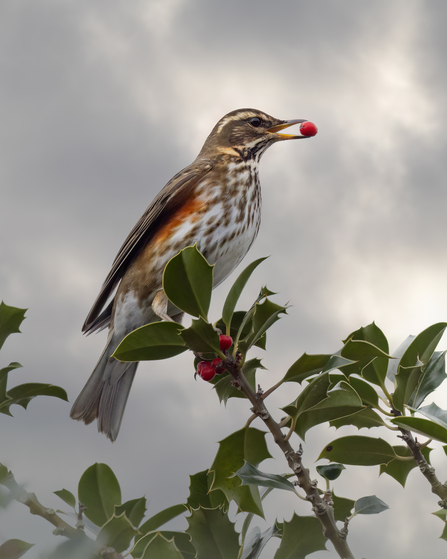Finally, autumn is here. The golden brown leaves have tumbled from the trees, thrushes are munching on berries and the sun is slinging low over Norfolk. So on a bright, crisp November day, I ventured out to our newest nature reserve - Sweet Briar Marshes - for a guided walk.
Sweet Briar was bought by NWT two years ago, funded generously by Aviva and donations from the public. They each contributed a mammoth £300,000 to the purchase of this piece of land, well over the required budget. This was fortunate, because the reserve already hosts some scarce species, such as marsh orchids. I'm not a botanist myself, but I am assured that there are many rare plants about.
Entering the reserve, I was greeted by the warden and head of urban reserves, Matt Wickens, who told me about how they acquired Sweet Briar. "After the public fundraiser, Aviva matched it pound for pound," he told me, showing just how important our sponsors are. Soon, we set off onto the marsh for our tour.

Redwing (credit: Jon Hawkins)
The majority of the ground was damp meadow grassland, crucial for rare flowers. Scattered throughout was a smattering of scrub: I thought about its potential to hold a plethora of passerine birds in the near future.
Down on the floodplain (supporting migrant woodcock and snipe), a pair of immaculate herons swooped low, looking for suitable fishing areas. The crimson berries on the hawthorn scrub were an advertisement to a winter migrant - the redwing. They occasionally peeled off in groups, soon to swoop back to their seemingly inexhaustible feast. You can see why the birds migrate here from Scandinavia: the area was washed red by the sheer amount of food! Redwings are really quite beautiful thrushes: a warm chocolate-brown, face marked with lingering buff stripes, belly inked with the colour of soot and, of course, the rich crimson underwing to match their food! As we progressed, more zoomed from the bushes and circled over our heads.
We travelled deeper into a denser habitat, still laden with berries. The warden talked of its potential for rare visitors like waxwings, and that earlier this year it had hosted a nightingale. If this vital habitat is revived and maintained, then who knows how many breeding birds it could host?
Certainly, this urban reserve could be even more of a haven for nature if nurtured and given its already present abundance of plant life, we are well on the way.
Shaggy inkcap fungi (credit: Tom Hibbert)
We next dropped into a light woodland, where I finally managed to get a photo of a vaguely obedient redwing. Here we also found the intriguing shaggy inkcap mushroom; it exudes a poisonous black, ink-like liquid as it grows older, hence the name. Then it hit eleven o'clock, so silently we paused for a moment of reflection. After this moving but slightly surreal two minutes mourning encircling a mushroom, we awakened ourselves from the trance and continued, much as before.
Soon we descended even further into a wet oak woodland, another key habitat for wildlife. Oaks support countless species: little owls, bracket fungi, purple emperor butterflies and willow warblers (oddly named considering their preference for oakwoods) just to name a few. I shall have to find out why willow warblers are so-called. Shafts of light cracked through the oak branches, beautifully lighting the scene of dried-up dead leaves. It is in moments like these that you realise autumn is really here. All these habitats add up to a perfectly calculated, diverse reserve.
It was almost time to leave as we entered another scrubland. But something was notably amiss: one patch of grassland was full of the beautiful and curious snow-white faces of yarrow flowers, the other much more sparsely decorated. The warden then explained that a fire had taken place earlier in the year, causing a late flowering season and more autumn nectar for late bees and butterflies. Even in the darkest hour, nature fights back.
When, finally, it was the time to split apart back to our normal lives and away from the madness of birdwatching, the local parakeets hallooed us on our return. One thing is certain – Sweet Briar is a very special place, and I look forward to the public opening in the spring!

